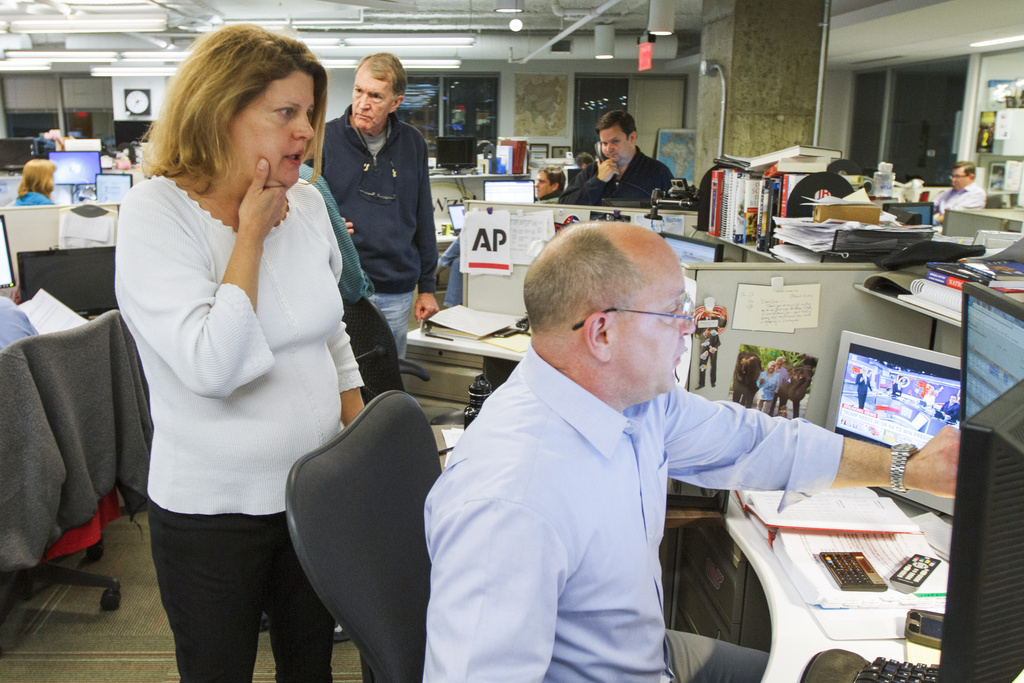For more than 175 years, The Associated Press has provided a critical service by calling U.S. presidential elections. What began in the 1800’s with Pony Express riders collecting results on horseback, has grown into a network of thousands of stringers, researchers, reporters, analysts, editors, data journalists and race callers compiling voting results for races all across the country.
In November, the race calling team will be responsible for calling election contests in every city and township across the United States. A consortium of media outlets rely on The AP each election cycle for their election calling services.
Sally Buzbee, former executive editor of both The Associated Press and The Washington Post, and current visiting fellow at the Nieman Foundation, spoke with Nieman Reports about what goes into the election night process. During her time at AP, which she left in 2021, Buzbee oversaw the AP’s race calling, election analysis, and exit poll work.
She spoke about recent changes in political polling, the challenge of reporting on close races, and covering elections in a climate of growing distrust. This conversation has been edited for length and clarity.
Can you walk us through the process of calling a race on election night? Is there an editorial process that information has to go through while gathering electoral data?
So, race calling definitely goes through an editorial process. It’s a bit of statistics, it’s a bit of reporting. I think of it as a kind of journalism, but it’s a more technical kind of journalism.
Let’s just say, Hillary Clinton and Donald Trump in Wisconsin [in 2016.] It’s a good, clean example. What you’re basically trying to figure out is, as the vote count comes in, and as somebody has a lead, do they have a lead that is big enough that no matter how many more votes come in, will [they] keep that lead?
So it’s just a probability thing. What you’re looking at is how much [of the] vote is still not reported by the state, and where that vote comes from. Does it come from the cities in Wisconsin, Milwaukee, and Madison, which are going to trend more Democratic, or does it come from the rest of Wisconsin, which is going to trend more Republican? You’re using deep reporting knowledge of Wisconsin [and] normally you have somebody [on staff] who knows something about Wisconsin politics and the history of Wisconsin politics.
I’m using this example on purpose, because in 2016 … as the vote started to come in from Wisconsin, Donald Trump had enough electoral votes that if he won Wisconsin, he would be certain to be elected president. It was about one-thirty or two o’clock in the morning, and we knew a bunch of votes came in from Milwaukee, which favored Mrs. Clinton over Donald Trump, but they weren’t enough to cut into his lead. We knew based on, essentially, the margin that she was winning by in Milwaukee was not big enough for her to win the state. When that became certain, then we said Donald Trump has won Wisconsin and therefore will be the next president of the United States. And that’s what we based it on. So that’s the essentials of race calling.
How do you actually get the vote totals you’re analyzing? Are there staff members reporting from each state on election night?
Right now, in the United States, there are two really big tabulators of the vote beyond the government. One of them is AP, which has a system of stringers — actual people who are calling in results — scraping state websites, and [performing] quality control. The second is a consortium of the networks who work with a group called Edison Research.
So the vote count is coming into AP’s computer system, and then you probably have some other analytical tools, like AP VoteCast, or the exit polls — they might be showing you trends. You don’t depend on [the polls] too much, but depend on them some. Because, for example, in a state that has historically always voted Republican — let’s just pick an easy one, like Alabama. Alabama is going to vote for Donald Trump. So when the polls close, you would probably [try] to get a smattering of the Alabama reports’ first round of results.
A lot of race calling organizations like the [broadcast] networks and AP have a program that basically randomly samples [those initial reports] and if it looks right — there’s no county or precinct that’s out of whack with what your expectation is — you then call that race on a very thin slice of actual vote count. Because the trends are just in line with 50 years of voting. So sometimes you use the exit polls or AP VoteCast to validate that.
After the 2016 presidential election, you made the decision that the AP would no longer use traditional exit polls to help with race calling. In 2020, the AP developed a new tool called VoteCast. Why was that change important?
Polling has had so many challenges in the last 10 years. AP participated in exit polls for many, many years, and it was a consortium of the [news] networks, and AP that was involved in that. One of the problems was that as more of the vote happened either before election day — in person or by mail.The people who actually go to polls on Election Day are actually just a subset of [all voters]. … Depending on the state, they’re actually a specific group: they tend to be older, more committed voters. So you’re getting an inaccurate snapshot.
Secondarily, there’s a fair amount of potential bias built into face-to-face questioning. … As trust in institutions was going down, [the bias] was actually getting worse. We also felt that all of this was kind of showing up in the exit poll data, and it was having to be weighted more and more and adjusted more and more. At some point, AP got uncomfortable with that level of [weighting of] the underlying methodology. Although it still had a lot of value to it, it just needed to be tweaked so much that … we lost confidence in it.
There used to be a ton of suspicion of online polling. The gold standard was phone polling, but then everyone stopped using landlines, and so phone polling became more difficult. It turned out that about the time when all this was happening, online polling was actually making some really great strides. If you get a big enough group of people, and then you random sample within that very large group of people, you can actually get very good results. By doing it online, you’re able to capture people regardless of when they vote. … We just felt that it had more potential to be accurate.
During your time as executive editor at the AP, you’ve said election night was “the most intimidating part of the job.” Can you describe the pressure? What was the most challenging aspect of race calling?
If it was a large margin race, there were editors called decision editors who would just go, “Okay, show me your data, okay, yes, that looks like it’s totally straightforward.” Once they signed off on it, an [AP news] alert would be written. … But if the race was a lot closer, then the scrutiny by the decision desk editors was much more intense. And very often there would be a situation where a race caller would say, “I feel like this race is getting close,” and the decision desk editor would look at it and go, “This makes me nervous. The vote from X county has been coming in kind of slow. I think you really just need to wait to see 20% more of the vote before we talk about this.” So they’re basically talking back and forth as the night goes on.
As the executive editor on the very, very tense calls, especially when they’re very close and when they are very consequential, I would have to sign off on those and understand the data and thinking behind them before we would do it.
What advice would you give to newsrooms covering U.S. elections in this particularly polarized era?
Julie Pace, who’s now the executive editor of AP, was quoted saying that AP this time around is trying to provide even more transparency about how race calls are done, and why a particular race call was made. Because I do think that there’s more scrutiny, there’s more pressure, certainly, and there’s more partisanship.
We started when I was there explaining how and what you did [to determine] that race call. The American system is very weird. In a place like France, there’s a government agency that tabulates the vote in real time and releases it. And in the United States, the vote for president is super decentralized. So each state runs its own vote, its own elections, and because of that, the results get reported in different ways.
But it’s also [related to] things like why do news organizations call races? Why isn’t there a government agency that just says this person won? They certify the vote, but they do that four weeks later. And people want to know on election night, or as close after election night as possible, and so that’s why media race calling [was] developed.
What are some of the key issues you think deserve more attention in this election cycle?
I would say that it’s very important to know that the race is very close and is a reflection of the country. And I think that, as journalists, we still haven’t totally gotten our heads around just how completely divided the country is. I would urge as much focus as possible on issues.
I think the thing that is probably most neglected this time around is actually [stories about the] economy and economic policy. Voters still feel that inflation is affecting them more than sometimes economists think. So we tend to ignore that story, but it is what a lot of people are actually saying they’re going to make decisions on.
The reality is that both of these people who are running for president have histories. Trump was president, we know some of the things he did when he was president. I think that coverage of some of that stuff is pretty valuable. Harris has been vice president, and so it’s completely important for journalists to [ask], “What would she do on immigration? We know what Biden did on immigration. What would she do?”
We know that the audience is highly interested in the horse race because it’s an extraordinarily close race … but I think it would be better in the horse race stories to throw some substantive stuff in there, and then also to just link, link, link. If somebody’s reading the horse race, that might be an opportunity to pull them to another story that talks about some issue. I just get very nervous about all the issue stories [that] are really long and really wonky, and all the horse race stories are fun to read. I think we have to figure out ways to make issues stories more accessible and digestible.



